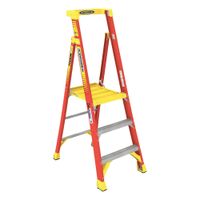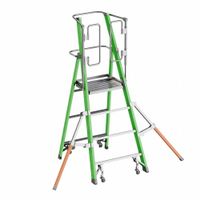Call +(254) 703 030 000 / 751 483 999 / 721 704 777
- Home
- Material Handling
- Ladders Platforms Personnel Lifts
- Ladders
- Platform Stepladders
.....Read More
Frequently Asked Questions
What is the difference between a platform stepladder and a podium stepladder?
A platform stepladder and a podium stepladder are both types of ladders designed for stability and safety, but they have distinct features and uses.
A platform stepladder is a self-supporting ladder with a flat, stable platform at the top, which provides a secure standing area for the user. The platform is typically surrounded by a guardrail or handrail for added safety. This type of ladder is ideal for tasks that require the user to stand in one place for an extended period, such as painting or installing fixtures. The platform allows for a comfortable stance and reduces fatigue, while the guardrails offer additional support and balance.
On the other hand, a podium stepladder is designed with a larger, more spacious platform and often includes a wrap-around guardrail system. The podium ladder's platform is typically higher than that of a standard platform stepladder, providing an elevated working height. The wrap-around guardrail offers 360-degree protection, allowing the user to work facing any direction with enhanced safety. This makes podium ladders particularly suitable for tasks that require frequent movement or reaching in different directions, such as electrical work or maintenance tasks.
In summary, the main differences lie in the size and design of the platform and the level of safety features. Platform stepladders are suitable for tasks requiring stability and comfort, while podium stepladders offer greater height and mobility with enhanced safety features for more dynamic tasks.
How do guardrails on platform stepladders enhance safety?
Guardrails on platform stepladders enhance safety by providing physical barriers that prevent falls, offering stability, and ensuring user confidence. They serve as a protective boundary around the platform, reducing the risk of accidental slips or missteps. By enclosing the user, guardrails minimize the likelihood of overreaching, which is a common cause of ladder-related accidents.
The presence of guardrails also aids in maintaining balance. When users have a secure structure to hold onto, it stabilizes their posture and reduces the chances of losing balance. This is particularly beneficial when working at height, where even minor movements can lead to instability.
Guardrails also act as a psychological safety net, boosting user confidence. Knowing there is a barrier in place allows users to focus more on the task at hand rather than worrying about potential falls. This increased focus can lead to more efficient and effective work.
Additionally, guardrails can serve as a support for tools and materials, keeping them within easy reach and reducing the need for unnecessary movements that could compromise safety. This organization helps in maintaining a clutter-free platform, further minimizing trip hazards.
In summary, guardrails on platform stepladders enhance safety by preventing falls, providing stability, boosting user confidence, and facilitating a safer working environment.
What are the benefits of using a safety-cage podium stepladder?
A safety-cage podium stepladder offers several benefits, enhancing both safety and efficiency in various work environments:
1. **Enhanced Safety**: The safety cage provides a 360-degree enclosed platform, reducing the risk of falls from height. This enclosure offers stability and support, allowing workers to focus on tasks without worrying about balance.
2. **Increased Stability**: These ladders are designed with a wide base and non-slip feet, ensuring a stable foundation. This minimizes the risk of tipping over, even on uneven surfaces.
3. **Improved Reach**: The podium design allows workers to stand comfortably at a higher elevation, providing better reach and access to elevated areas without the need to overextend or lean dangerously.
4. **Hands-Free Operation**: The enclosed platform allows workers to use both hands freely, improving productivity and reducing the risk of accidents associated with one-handed operations.
5. **Ergonomic Design**: The ladder's design reduces strain on the body by allowing workers to stand upright rather than leaning or stretching, which can lead to fatigue and injury.
6. **Versatility**: Safety-cage podium stepladders are suitable for a variety of tasks and industries, from construction to maintenance, making them a versatile tool for different applications.
7. **Compliance with Safety Standards**: Many safety-cage podium stepladders meet or exceed industry safety standards, ensuring compliance with occupational safety regulations and reducing liability risks.
8. **Durability**: Constructed from robust materials, these ladders are built to withstand heavy use and harsh conditions, offering long-term reliability and cost-effectiveness.
9. **Ease of Use**: Designed for quick setup and easy maneuverability, these ladders can be efficiently deployed and repositioned, saving time and effort on the job site.
Overall, safety-cage podium stepladders provide a secure, efficient, and ergonomic solution for working at heights, enhancing both safety and productivity.
How high are the guardrails on a twin platform stepladder?
The guardrails on a twin platform stepladder are typically around 36 to 42 inches high from the platform. This height is designed to provide adequate support and safety for users while they are standing on the platform, helping to prevent falls. The exact height can vary depending on the manufacturer and model, but it generally adheres to safety standards and regulations to ensure user protection.
Are platform stepladders suitable for long-duration tasks?
Platform stepladders can be suitable for long-duration tasks, but their appropriateness depends on several factors. These ladders are designed with a flat, stable platform at the top, providing a more comfortable standing area compared to traditional rung ladders. This feature can reduce fatigue during extended use, making them a good choice for tasks that require prolonged standing.
The stability and comfort of platform stepladders make them ideal for tasks like painting, electrical work, or maintenance, where the user needs to remain at a certain height for an extended period. The platform allows for a more natural stance, reducing strain on the feet and legs. Additionally, many platform stepladders come with safety rails or handrails, offering extra support and reducing the risk of falls.
However, the suitability of platform stepladders for long-duration tasks also depends on the specific working environment and task requirements. For instance, if the task involves frequent movement or repositioning, a platform stepladder might be cumbersome due to its size and weight. In such cases, a lighter, more portable ladder might be preferable.
Moreover, the height of the task is a critical consideration. Platform stepladders are generally suitable for low to medium-height tasks. For higher tasks, scaffolding or other specialized equipment might be more appropriate to ensure safety and efficiency.
In conclusion, while platform stepladders can be suitable for long-duration tasks due to their comfort and stability, their effectiveness depends on the task's nature, height requirements, and the need for mobility. Users should assess these factors to determine the best equipment for their specific needs.
What safety features should I look for in a podium stepladder?
When selecting a podium stepladder, prioritize the following safety features:
1. **Sturdy Construction**: Ensure the ladder is made from high-quality materials like aluminum or fiberglass for durability and stability.
2. **Non-Slip Platform**: The podium should have a large, non-slip surface to provide a secure standing area and reduce the risk of slipping.
3. **Guardrails**: Look for guardrails around the platform to prevent falls and provide additional support when working at height.
4. **Locking Mechanism**: A reliable locking system is essential to keep the ladder stable and prevent accidental folding during use.
5. **Wide Steps**: Steps should be wide and have non-slip treads to ensure safe climbing and descent.
6. **Load Capacity**: Check the ladder’s weight rating to ensure it can support the user and any tools or materials being carried.
7. **Stabilizing Feet**: Non-slip, rubberized feet or stabilizers help prevent the ladder from slipping on various surfaces.
8. **ANSI/OSHA Compliance**: Ensure the ladder meets or exceeds safety standards set by the American National Standards Institute (ANSI) and the Occupational Safety and Health Administration (OSHA).
9. **Easy Portability**: Features like wheels or a lightweight design can make it easier to move the ladder safely.
10. **Height and Reach**: Choose a ladder with an appropriate height and reach for your specific tasks to avoid overreaching.
11. **Tool Tray or Holder**: A built-in tool tray or holder can keep tools within reach, reducing the need to climb up and down frequently.
12. **Inspection and Maintenance**: Regularly inspect the ladder for any signs of wear or damage and ensure it is maintained according to the manufacturer’s instructions.
How do I choose the right stepladder for my needs?
1. **Purpose and Frequency of Use**: Determine if the ladder is for occasional household tasks or frequent professional use. Heavy-duty tasks require a more robust ladder.
2. **Height Requirements**: Measure the maximum height you need to reach. Choose a ladder that allows you to work comfortably without overreaching. The highest standing level should be two steps below the top.
3. **Weight Capacity**: Check the ladder's duty rating, which indicates the maximum weight it can support, including the user and any tools. Common ratings are Type III (200 lbs), Type II (225 lbs), Type I (250 lbs), Type IA (300 lbs), and Type IAA (375 lbs).
4. **Material**:
- **Aluminum**: Lightweight and corrosion-resistant, suitable for most indoor tasks.
- **Fiberglass**: Heavier but non-conductive, ideal for electrical work.
- **Wood**: Traditional and sturdy, but can be heavy and susceptible to weather damage.
5. **Design and Features**:
- **Step Ladder**: A-frame design, stable for indoor use.
- **Platform Ladder**: Offers a larger standing area for comfort.
- **Multi-Position Ladder**: Versatile, can be configured in various ways.
- **Extension Ladder**: Best for reaching high places, like roofs.
6. **Safety Features**: Look for slip-resistant steps, locking mechanisms, and stabilizing bars. Ensure it meets safety standards like ANSI or OSHA.
7. **Storage and Portability**: Consider the ladder's weight and folded size for easy storage and transport.
8. **Budget**: Balance cost with quality and features. Investing in a durable ladder can be cost-effective in the long run.
9. **Brand and Reviews**: Research reputable brands and read customer reviews for reliability and performance insights.


